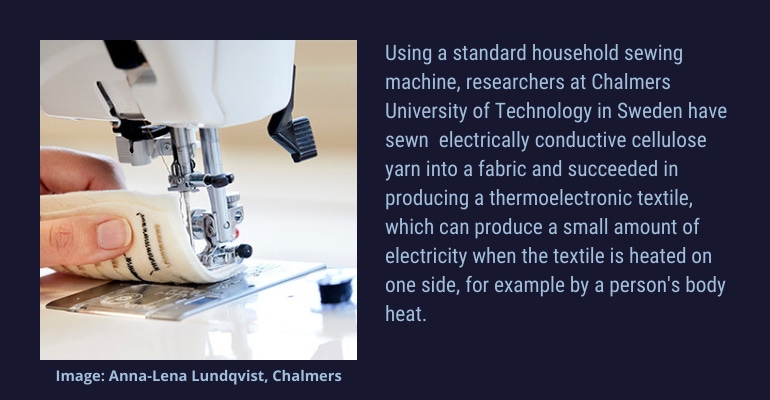March 15, 2021

Electronic textiles offer revolutionary new opportunities in various fields, in particular healthcare. But experts say that to be sustainable, they need to be made of renewable materials. A research team led by Chalmers University of Technology, Sweden, has found that a thread made of conductive cellulose offers fascinating and practical possibilities for electronic textiles.
“Miniature, wearable, electronic gadgets are ever more common in our daily lives. But currently, they are often dependent on rare, or in some cases toxic, materials. They are also leading to a gradual build-up of great mountains of electronic waste. There is a real need for organic, renewable materials for use in electronic textiles,” said Sozan Darabi, a doctoral student at the Department of Chemistry and Chemical Engineering at Chalmers University of Technology and the Wallenberg Wood Science Center, and lead author of the scientific article, which was recently published in ASC Applied Materials & Interfaces.
Together with Anja Lund, a researcher in the same group, Darabi has been working with electrically conductive fibres for electronic textiles for several years. The focus was previously on silk, but now the discoveries have been taken further through the use of cellulose.
The results presented by the researchers show how cellulose thread offers huge potential as a material for electronic textiles and can be used in many different ways. Sewing the electrically conductive cellulose threads into a fabric using a standard household sewing machine, the researchers have now succeeded in producing a thermoelectric textile that produces a small amount of electricity when it is heated on one side – for example, by a person's body heat. At a temperature difference of 37 degrees Celsius, the textile can generate around 0.2 microwatts of electricity.
“This cellulose thread could lead to garments with built-in electronic, smart functions, made from non-toxic, renewable, and natural materials,” Darabi said.
The production process for the cellulose thread has been developed by co-authors from Aalto University in Finland. In a subsequent process, the Chalmers researchers made the thread conductive through dyeing it with an electrically conductive polymeric material. The researchers' measurements show that the dyeing process gives the cellulose thread a record-high conductivity – which can be increased even further through the addition of silver nanowires. In tests, the conductivity was maintained after several washes.
Electronic textiles could improve our lives in several ways. One important area is healthcare, where functions such as regulating, monitoring, and measuring various health metrics could be hugely beneficial.
“Cellulose is a fantastic material that can be sustainably extracted and recycled, and we will see it used more and more in the future. And when products are made of uniform material, or as few materials as possible, the recycling process becomes much easier and more effective. This is another perspective from which cellulose thread is very promising for the development of e-textiles,” said Christian Müller, research leader for the study and a professor at the Department of Chemistry and Chemical Engineering at Chalmers University of Technology.
This work of the research team from Chalmers is performed within the national research center Wallenberg Wood Science Center, in cooperation with colleagues in Sweden, Finland, and South Korea.
Read the article in the scientific journal ASC Applied Materials & Interfaces: Green Conducting Cellulose Yarns for Machine-Sewn Electronic Textiles
About the Author(s)
You May Also Like

.png?width=300&auto=webp&quality=80&disable=upscale)
